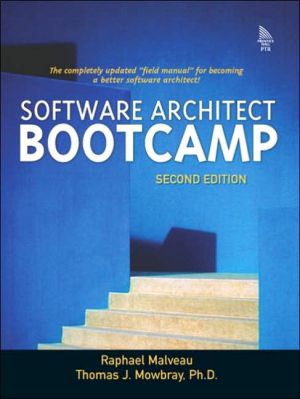Software Architect Bootcamp
The completely updated "field manual" for becoming a better software architect!\ The crucial skills you need to survive and thrive as an enterprise software architect! Fully updated for the latest techniques-from lightweight methods and architectural layers to Model-Driven Architecture and UML 2.0!\ In this book, Raphael Malveau and Thomas J. Mowbray share up-to-the-minute insights and practical solutions for all the key challenges of building enterprise software systems with objects,...
Search in google:
Written for software developers seeking career advancement, this book describes the discipline and process of writing specifications as well as the human aspects of the practice that are challenging to software architects. It compares the major object-oriented and network technologies, presents options for managing complexity on a small scale, and offers advice on developing leadership and team building skills. The second edition adds sections on enterprise architecture and model-driven development. Annotation ©2004 Book News, Inc., Portland, OR
Preface\ Why have a second edition of Software Architecture Bootcamp? It is safe to say that there have been sweeping changes in the IT industry since the release of the first edition. The era of limitless demand for IT talent is over. The balance of power has shifted away from IT shops and back toward the business and financial areas. No longer will a nifty technical idea spur large investments without a sound business plan and proven management expertise.\ Companies no longer race to make IT investments to gain competitive edge. Such thinking has been replaced by the need to justify IT investments by demonstrating how greater efficiencies and return on investments will be achieved . Corporations are more willing now than ever to alter their business processes in order to make better use of commercial products or outsourcing.\ Few people will be successful in the current IT environment for very long simply by developing software. Now, more than ever before, it is absolutely imperative to create additional value. Corporations have also realized that speed in developing software solutions is not beneficial to them if the software does not meet their business needs and if it is not of sufficient quality to be dependable. The business community has come to realize that quality matters, planning matters, and technical leadership that incorporates both matters. Rather than having business analysts and marketing departments rack their brains to figure out how to use their IT group to achieve business advantage, the burden has shifted to the IT group and the expectation that it will have the business acumen to align its focus with that of the organization. While this is not new for some organizations, it is very different than the way IT business was conducted at the height of the IT boom when the "new economy" IT gurus would advocate rushing something to market first in the hope that a market could be identifed or developed for it down the road.\ In addition to the business environment—the mainstream—most relevant technologies have changed considerably. Interestingly, while it is a different world, it is also, in many respects, a far simpler world than it was a few years ago. While there have been a number of new technologies introduced, they have been offset by the rapid consolidation of technical approaches and supporting products. Internet technologies are the undisputed king, especially for interoperability between corporations. Microsoft has been wildly successful in its efforts to develop an enterprise platform that rivals the developments occuring in the Java community. During the lengthy recession at the start of this century, IT companies either consolidated or they failed, leaving a more managable number of solutions, most of which were interoperable with one or both of the major enterprise platforms. To a large degree, innovative solutions escaped the middleware layer of the enterprise and focused more on meeting specific business needs where a larger financial payoff exists. In order to maintain technical leadership, software architects need guidance on new technological areas not addressed in the first edition, such as enterprise architecture and model-driven development. The second edition also gives greater emphasis to working with project management to satisfy business objectives.\ Finally, we felt that there was an opportunity to do a better job with the timeless topics by providing more specifics and introducing greater clarity to the material presented. We were concerned that the first edition might have been misperceived as focusing too much on career advancement. We hope this new edition will make it clear that our primary purpose is to equip software architects with the tools to deliver greater value to projects. Few people remember the architects of the cornerstones of civilization—Egypt, Rome, and New York. However, all remember their creations. It is what gets created and built that matters, not the architects or other team members behind them.\ In summary, this book has been updated to better meet the needs of software architects today. The second edition gives you the essential information to succeed as a software architect with an emphasis on the specific needs of projects in the current IT environment. Since the prosperous times that existed when the first edition was released may not return for a long time, it is important that software architects have a broad base of skills to meet challenges beyond the technical or organization areas. The new edition of Software Architecture Bootcamp provides a crucial portion of the knowledge base software professionals require in order to remain major contributors of value to organizations and customers.\ RAPHAEL MALVEAU THOMAS J. MOWBRAY, PH.D. McLean, Virginia, U.S.A.
Preface xviiAcknowledgments xix Introduction 1 Software Architecture: Basic Training 41 Software Architecture: Going to War 93








